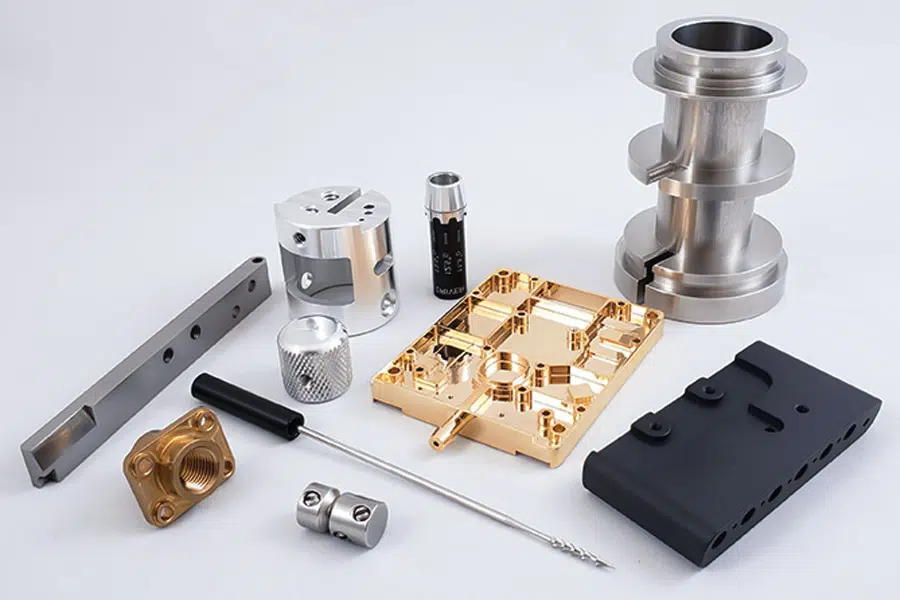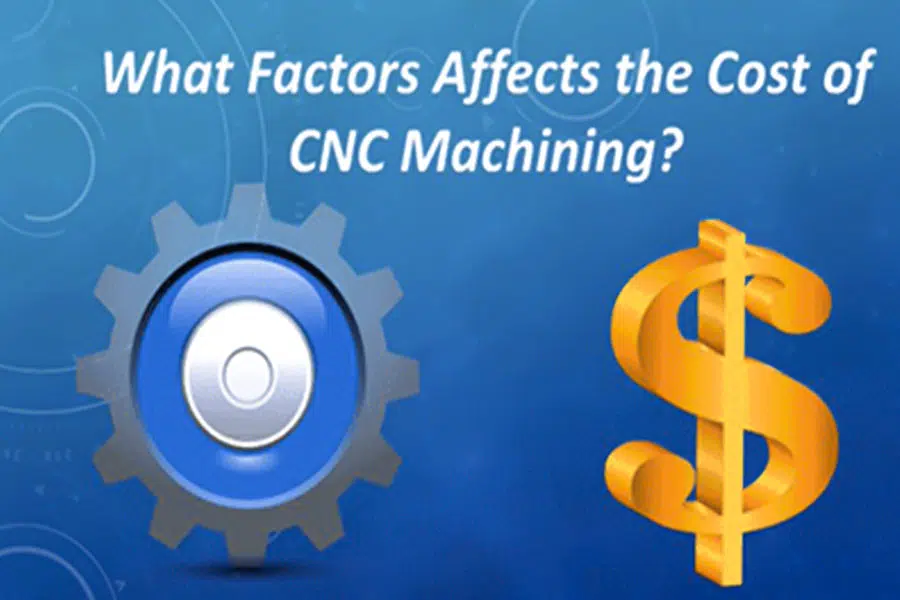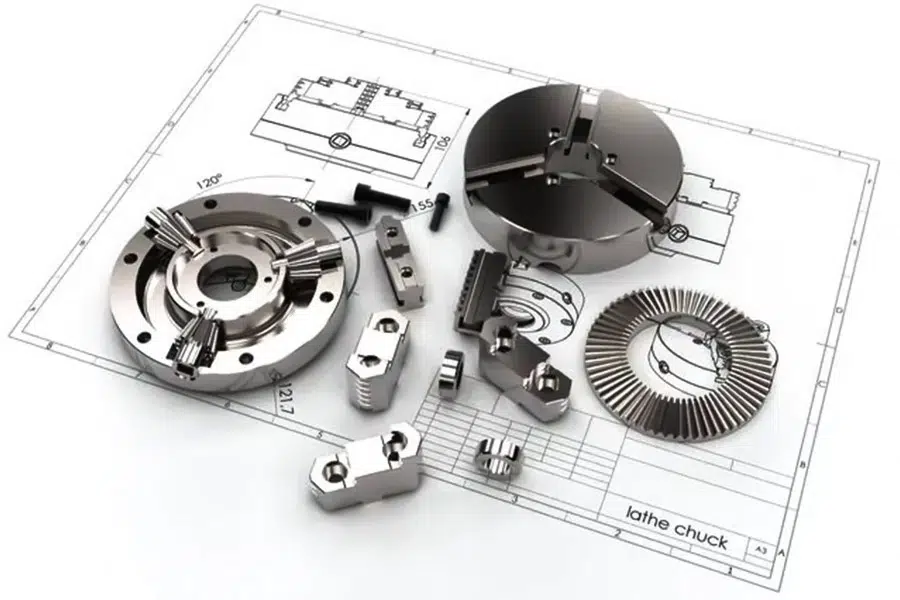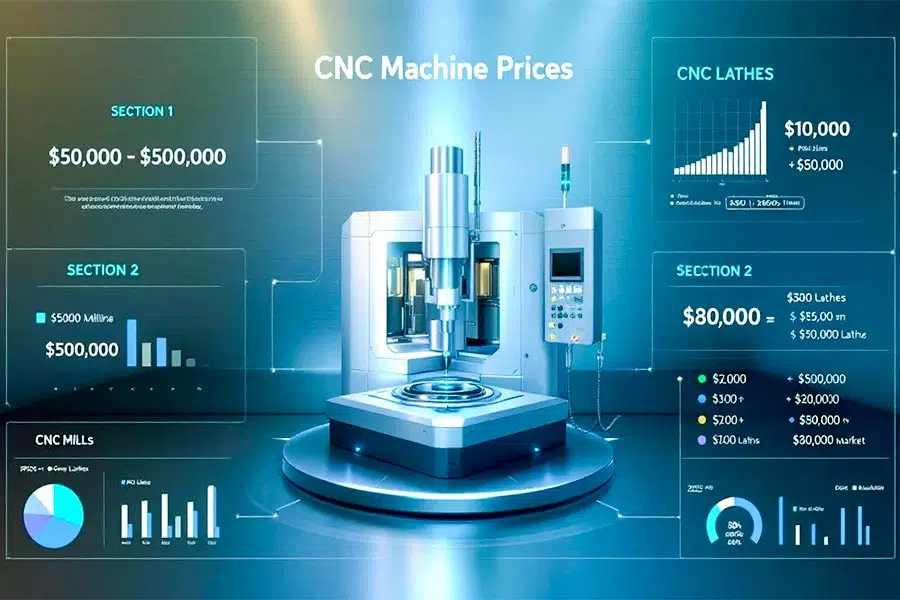In the manufacturing field, CNC machining technology is widely popular because of its excellent high precision, high efficiency and high flexibility. However, when companies face choosing CNC machining services, price factors usually become an important part of their trade-off. So, how is the price of CNC machining affected by various factors? This article aims to provide an in-depth analysis of the core factors that affect CNC machining prices, and with the help of market data analysis and actual cases, you can have a clearer understanding of the cost structure and make a more informed choice.
Learn about CNC machining and its costs
CNC stands for computer numerical control. CNC machining, therefore, is the process of running an automated or computer-controlled machine according to a set of preprogrammed prompts to perform precision manufacturing tasks.
With CNC machines, production processes such as cutting and forming can be completed in less time and with greater precision. Additionally, CNC machining operations require only a single line of code to complete some multi-pass operations.
These explanations suggest that CNC machining is high-tech and may include some inherent cost planning. Let’s take a look at what are the factors that affect CNC machining costs?

What Are the Key Factors Affecting CNC Machining Prices?
Understand the factors that influence the final pricing of CNC machined parts. Proper understanding of these factors will help in calculating CNC machining costs.
1.Material cost
In machining prices, the choice of material type plays a crucial role. The differences in hardness, toughness, cutting performance and other characteristics of various materials may lead to different machining difficulties and the diversity of tools required. For example, titanium alloys are not only expensive, but also extremely difficult to process, which makes their machining costs relatively high. Although stainless steel has excellent performance, it is easy to stick to the tool during processing, causing greater wear to the tool, which may also increase machining costs.
According to a market procurement cost survey we conducted, the price of aluminum alloy is approximately US$3-5 per kilogram, the price of stainless steel is between US$5-8 per kilogram, and the price of titanium alloy is as high as US$30-50 per kilogram.
- Case1: Take an aerospace company as an example. They need to process a batch of titanium alloy parts. Due to the high cost of titanium alloy, the material cost of this batch of parts actually accounted for 40% of the total processing cost. This high proportion fully illustrates the importance of material selection in machining costs.
2.Part design complexity
At the design level, part complexity is an important factor that directly affects processing costs. For those machining processes that involve non-standard parts, special hole design, and specific clamping tools, they often require additional technology and longer time to complete, which will undoubtedly increase machining costs. Specifically, the more complex the geometry of the part, the more difficult it is to process. For example, it may only take 1 hour to process a simple shaft part, but it may take up to 10 hours to process a complex turbine blade.
- Case 2: An auto parts supplier needs to process a batch of complex engine blocks. Due to the complex design, the machining time is three times longer than that of ordinary parts, resulting in a significant increase in costs.
3.machining equipment cost
When evaluating the cost of CNC machining, the first step is to estimate the total operating time of the CNC machine in a year (in hours) and calculate the unit hourly cost based on this. This needs to take the machine price into consideration. At the same time, in order to compensate for possible wear and tear, a certain percentage of the cost of the special tool drill bit needs to be added to the calculation.
The specific type of CNC machining and the tools used have a direct impact on the budget and overall machining costs. For example, parts with complex designs and diverse features may require as many as 3 to 4 setups on a 3-axis machine. However, with more advanced multi-axis machines (such as 5-axis machines), the number of setups may be reduced to just two for the same part.
It is worth noting that although the hourly machining cost of multi-axis machine tools in Europe may be as high as $25, choosing a top Chinese manufacturer such as Longsheng can achieve the same high level of machining accuracy and quality at a preferential price of only $8/hour (i.e. 55 yuan/hour).
- Case 3: A medical equipment manufacturer uses 5-axis CNC machine tools to process a batch of high-precision surgical instruments. Although the cost of the equipment itself is relatively high, due to the ability to reduce processes and improve processing accuracy, the overall cost is ultimately reduced by 15%.
4.machining time
In CNC machining costs, machining time plays a decisive role. The extension of machining time directly leads to an increase in the time occupied by machine tools and an increase in the use of consumables (such as tools, coolant, etc.), which in turn drives up the overall cost. Especially for parts with complex structures, the programming time may account for up to 20%-30% of the entire processing cycle.
- Case 4: An electronics company needs to process a batch of connectors with complex structures. Because the programming of these connectors takes a long time, the overall processing cost ultimately rises by 25%.
5.Labor cost
Although the operation of CNC machines has been highly automated, labor costs still occupy an important position that cannot be ignored when calculating CNC machining costs. Although the manpower required is relatively small, labor cost calculations are still necessary.
No matter how complex the design of the mechanical part to be machined is, at least one programmer and one manufacturing engineer are required. Some CNC machine manufacturers may choose to outsource these services, depending on whether they have the design and programming expertise themselves.
In addition, with the rapid development of CNC manufacturing, they must also factor in the cost of training machine operators into the overall consideration. Machinists need to constantly update their knowledge and become proficient in the latest maintenance and production technologies. In Europe and the United States, the average salary level for CNC technicians is between US$30-50 per hour, while in Asia, this salary level may be as low as US$10-20 per hour.
- Case 5: A European manufacturer chose to outsource part of its CNC machining business to Chinese suppliers. By taking advantage of relatively low local labor costs, the manufacturer managed to save up to 30% on processing expenses.
6.Production batch size
Small batch production models are often accompanied by higher unit costs. Specifically, the unit cost of processing only 10 parts may be 2 – 3 times the unit cost of machining 1,000 parts.
- Case 6: Take a start-up company as an example. They need to process 50 prototype parts. Due to the smaller production batches, the unit cost of these parts is 40% higher than the mass production model.
7.Post-processing and finishing
Although post-processing and finishing steps incur certain additional costs, they play an integral role in ensuring that the product reaches the highest production quality. During the post-processing stage, manufactured parts undergo a series of rigorous quality assurance checks, including removal of excess material and performance testing to ensure the parts meet established quality standards.
The finishing process then uses a variety of coating techniques to further enhance the appearance and performance of the part, including but not limited to powder coating, anodizing, and sandblasting. In addition, the cost of post-processing and finishing also includes some other related expenses, such as packaging and shipping of the parts. In terms of cost, anodizing costs around $10-20 per square meter, while plating can cost as much as $50-100 per square meter.
- Case 7: A consumer electronics company needs to anodize the casings of its products. The company’s machining costs increased by 15% due to this specific surface treatment requirement.

How to calculate CNC machining cost?
Although CNC machining costs are not static, and some companies can provide real-time quotations to assist budget preparation, we can still clarify the calculation process.
First, a comprehensive CNC machining cost calculation formula should include all relevant factors. This covers material costs, setup and programming expenses, labor costs, machining and tool wear, special processing costs for part design and geometry, and total expenses in the post-processing stage.
Costs covered in the post-processing stage include inspection fees, processing fees, surface treatment technology fees, packaging fees and transportation fees. At the same time, special requirements for part design and geometry may trigger the cost of using specific tooling.
In addition, when calculating the cost, we also need to take into account the wear and tear caused by the use or purchase of special tools. This includes the depreciation value of the tools. At the same time, the hourly depreciation and maintenance costs of CNC machine tools are also factors that cannot be ignored.
Therefore, we can express the processing cost formula as
CNC processing cost = material cost + processing fee + additional cost
Example:
Suppose a company needs to process a batch of 100 parts made of aluminum 6061, and each part has the same size and shape. After calculation, the material cost is 5,000 yuan, the processing cost is 8,000 yuan (including equipment depreciation, labor, working hours, maintenance, etc.), and the additional cost is 1,000 yuan (including transportation, packaging, taxes, etc.). Therefore, the total processing cost of this batch of parts is 14,000 yuan.

What are some strategies for reducing CNC machining costs?
Have you gotten a cost quote from a manufacturing company and decided it was slightly over your budget? take it easy! The Longsheng team will help you how to reduce CNC machining costs without compromising the quality you need.
1.Review your material selections
Rethink your material choices to help minimize CNC machining cost calculations. Are there cheaper alternatives that work well? Will you sacrifice quality by choosing a cheaper option?
While workability is critical, you should choose materials that work well and are low-cost. The table below summarizes average lot costs for common metals/plastics.
(1)Metal material
| Type of material | The name of the material | Average Unit Cost (USD/Piece) | Analyse |
| Aluminum alloy | 6061 aluminum alloy | 5-15 | Lightweight, easy to process, widely used in the aerospace and automotive industries. |
| 7075 aluminum alloy | 8-20 | High strength, suitable for high-stress environments, but slightly more difficult to process. | |
| stainless steel | 304 stainless steel | 10-25 | High corrosion resistance for use in the food, medical and chemical industries. |
| 316 stainless steel | 12-30 | Corrosion-resistant and suitable for extreme environments. | |
| Titanium alloy | Titanium alloy (Ti-6Al-4V) | 50-100 | High strength and light weight, but difficult to process, high cost, suitable for aerospace and medical industries. |
| carbon steel | mild steel | 5-12 | Low cost, suitable for general mechanical parts. |
| Medium carbon steel | 6-15 | High strength, suitable for high-load parts. | |
| Copper alloys | brass | 10-20 | It has good electrical conductivity and is suitable for the electronics and electrical industries. |
| bronze | 12-25 | Good wear resistance, suitable for bearings and gears. |
(2)plastic material
| Type of material | The name of the material | Average Unit Cost (USD/Piece) | Analyse |
| ABS plastic | ABS | 3-8 | High strength, easy to process, suitable for prototypes and functional parts. |
| Polycarbonate (PC) | PC | 5-12 | High transparency, high impact resistance, suitable for optical and protective equipment. |
| Nylon (PA) | Nylon 6/6 | 6-15 | Good wear resistance, suitable for gears and bearings. |
| Polyoxymethylene (POM) | POM (Saigang) | 7-18 | High rigidity, low friction, suitable for precision parts. |
| Polyetheretherketone (PEEK) | PEEK | 50-150 | High-performance plastics that are resistant to high temperatures and chemicals for the aerospace and medical industries. |
| Polytetrafluoroethylene (PTFE) | PTFE (Teflon) | 20-50 | Chemically resistant, low-friction and suitable for seals and gaskets. |
The two tables above provide an overview of average batch costs for common CNC machining materials metals and plastics. When selecting materials, comprehensive considerations need to be made based on specific application scenarios, performance requirements, and cost budgets. Different materials have different characteristics and advantages, and choosing the most suitable material can optimize product performance and cost-effectiveness.
2.Optimize design and reduce costs
In order to reduce CNC machining costs and avoid complex designs. Simplification techniques are as follows:
- Adding a radius to the inner vertical edge reduces processing time and costs. It is recommended that constant radius < depth ⅓.
- It is difficult to process thin-walled materials, preferably metal >0.8mm and plastic <1.5mm.
- The design depth of the cavity is <4 times the diameter to avoid the need for special tools. Standard tolerance is ±0.005”, minus processing and inspection.
- Avoid text in CNC design, choose engraving letters, or replace it with painting or screen printing.
3.mass production
For companies seeking to reduce CNC machining costs, bulk purchasing and mass production are an effective strategy. In this way, unit costs can be significantly reduced because setup costs only need to be incurred once, rather than having to be recalculated for each production run. This means that when production costs are ultimately deducted from revenue, the business is able to maximize profits.
4.Optimize production time
Many shop managers tend to focus on the overall design process, but ignore the important consideration of “actual” CNC production time. Optimizing production time can be achieved in a variety of ways, such as optimizing cutting speed, increasing material feed rates and selecting the right tool. In addition, the cooling system needs to be inspected regularly and ensured that it is properly maintained to prevent production interruptions due to machine failure.
5.Efficient programming and tool path planning
In the CNC machining process, the use of efficient programming software can significantly improve machining efficiency. These software ensure that every cut is as efficient as possible by accurately calculating and optimizing tool paths. At the same time, reasonable tool path planning is also crucial. It requires planners to fully consider factors such as the shape and size of the workpiece as well as the hardness of the material to reduce unnecessary movements and empty tool strokes. By accurately controlling the movement trajectory of the tool, it can not only save processing time, but also effectively extend the service life of the tool, further improving the overall processing efficiency.
6.Use professional design software
Another effective way to help reduce CNC machining costs is to obtain professional design software. Such software can evaluate the feasibility of a design draft and provide valuable suggestions and improvements. In addition, design software also plays an important role in material selection, part design, geometry optimization, and tool path planning.
7.Choose the right machining plant
Choose an experienced and cost-effective CNC machining factory to ensure product quality and reduce machining costs. By working with Longsheng, you not only get low prices and fast delivery times, but you also get a variety of benefits. Through high-quality machining and flexible production capabilities, customers realize long-term value.

Longsheng: Your only supplier for customized parts
With over 15 years of manufacturing experience, we handle cnc parts with tolerance of up to 0.005mm, same day quotation, and 72 hours delivery. We have produced over 80,000 different parts of different quantity. Our aim is to provide top quality and high efficiency metal parts machining services for prototyping as well as mass production customers.Longsheng has been in a leading position in similar industries in CNC machining , injection molding, sheet metal Fabrication, metal stamping, rapid prototyping, 3D printing and other services.Turn your ideas into reality with our excellent on-demand manufacturing services to produce simple and complex prototypes and final parts, all of our products meeting strict tolerances and quality requirements.
Production equipment
Our manufacturing factory is equipped with advanced production lines that can handle a variety of materials, including metals, plastics, and composites. We utilize computer-aided design (CAD) and computer-aided manufacturing (CAM) software to program our machines, ensuring high precision and accuracy in every product we create.
International Accreditation
At our manufacture factory, quality is paramount. We are proud to hold various industry certifications, including ISO 9001:2015, which ensures our processes and products meet international quality standards. We also follow strict quality control measures throughout the production process to ensure the final product is of the highest quality.
24/7 Engineering Support
Longsheng provides you with an experienced team of service engineers to solve all your manufacturing problems. Not only can we help you optimize your design and reduce costs, but our senior engineers also provide professional guidance and beneficial DFM feedback, and achieve higher quality and more consistent quality control through standardized practices to ensure that your project achieves the best results.
Are you still confused about how to calculate CNC machining costs? Or do you feel like your budget might not be enough to purchase the parts you need? Don’t worry, Longsheng will help you solve all your confusions. In the past five years, Longsheng has never stopped making progress and has always been committed to providing customers with the best service. Your custom parts are half done when you choose Longsheng, we know your time is valuable, we know you want to maximize your profits, and we know what you really want is efficient delivery. We simplify the innovation cycle into four simple but effective steps. In just 3 days, you can get flawless parts! Start your processing project in Longsheng!
Conclusion
CNC machining prices are affected by many factors, including material cost, part complexity, processing equipment, labor cost, batch size, etc. Understanding these factors can help companies better control costs and find the most cost-effective solution when choosing CNC machining services. If you are looking for high-precision and high-efficiency CNC machining services, please contact us for customized quotations and professional advice.
Contact us now to get exclusive CNC machining solutions!
📞 Phone: +86 185 6675 9667
📧 Email: info@longshengmfg.com
🌐 Website: https://www.longshengmfg.com/
Disclaimer
The content appearing on this webpage is for informational purposes only. LongSheng makes no representation or warranty of any kind, be it expressed or implied, as to the accuracy, completeness, or validity of the information. Any performance parameters, geometric tolerances, specific design features, quality and types of materials, or processes should not be inferred to represent what will be delivered by third-party suppliers or manufacturers through LongSheng’s network. Buyers seeking quotes for parts are responsible for defining the specific requirements for those parts. Please contact to our for more information.
Team LongSheng
This article was written by various LongSheng contributors. LongSheng is a leading resource on manufacturing with CNC machining, sheet metal fabrication, 3D printing, injection molding,metal stamping and more.



Pingback: How to Estimate CNC Machining Costs?
Pingback: What Influences CNC Machining Pricing?
Pingback: What Are the Hidden Costs in CNC Machining?
Pingback: How to Compare CNC Machining Prices?